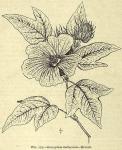 Bark, Hairs of Seed, and the Oil of Gossyp'ium herba'ceum Linné, and other species of Gossypium.
Bark, Hairs of Seed, and the Oil of Gossyp'ium herba'ceum Linné, and other species of Gossypium.
BOTANICAL CHARACTERISTICS OF GOSSYPIUM HERBACEUM.—Large herbs with alternate leaves, which are more or less palmately-lobed. Flowers are large, showy, more or less yellow or red; pistils 5, united at their base. Stamens numerous, united below and adhering to the petals. Capsule roundish, 3- to 9-celled, opening at the top by as many valves. The numerous seeds are glossy, covered with long, woolly hairs, which constitute the cotton.
HABITAT.—Asia and Africa; cultivated in the United States.
344a. ROOT BARK.—Gossypii Cortex, N.F. COTTON-ROOT BARK.—Long bands or curved pieces, sometimes in quills. The outer surface is of a yellowish-brown color, dotted with a few small black spots, and, from the abrasion of the thin cork, numbers of orange-brown patches; the inner surface is whitish and has a silky luster; the bast fibers are long and tough, and may easily be separated into papery layers; inodorous; taste very slightly acrid and astringent.
Powder.—Light brown. The microscopical elements are: The simple and compound starch grains, the aggregate calcium oxalate crystals, colored resin, and tannin masses; the numerous long, slender, and thick-walled bast fibers (8 to 15 µ thick), large cork cells, etc.
CONSTITUENTS.—A yellow resin, fixed oil, tannin (small quantity), sugar, starch, and, in the fresh bark, a yellow chromogen, which becomes red and resinous on exposure to the air. To this change is due the red color of old specimens, and old preparations, of the bark.
ACTION AND USES.—Emmenagogue and oxytocic, stimulating uterine contractions probably by direct action on the uterine center in the spinal cord; said to be as efficient and more safe than ergot. Dose: 15 to 60 gr. (1 to 4 Gm.).
344b. HAIRS OF SEED.—Gossypium Purificatum. PURIFIED COTTON, Fine, white, soft filaments, which, under the microscope, appear as hollow, flattened, and twisted bands; unacted upon by ordinary solvents. Ordinary raw cotton contains among other impurities fatty substances, which, when removed by chemical means, such as alkaline or ethereal solvents, changes its character so that the fiber, which formerly was almost impenetrable by aqueous liquids. now becomes so absorbent that it no longer floats on water, but when placed on the surface of that liquid will readily absorb it and sink.
CONSTITUENTS.—Almost pure cellulose; by the action of nitric acid this is converted into soluble gun-cotton.
ACTION AND USES.—Employed as a dressing for burns, scalds, and excoriated surfaces, and for making antiseptic cottons, such as salicylated cotton, benzoinated cotton., iodoform cotton, etc.
Pyroxylinum (Soluble Gun-cotton), the basis of the various official collodions.
344c. OIL.—OLEUM GOSSYPII SEMINIS. A fixed oil expressed from the seeds. Pale yellowish, odorless, with a bland, nut-like taste; specific gravity 0.920 to 0.930 at 15°C (59°F.), solidifying at about 0° to —5°C. (32° to 23°F.); very sparingly soluble in alcohol. Brought into contact with concentrated sulphuric acid, the oil at once assumes a dark reddish-brown Color. Color reactions with nitric acid and silver nitrate (see U.S.P. tests) distinguish this oil from other similar oils. The oil is used as a basis for Linimentum Ammoniae, Linimentum Camphorae, etc. Processes have been invented for purifying the crude oil to abstract its acrid resin, and so leave it bland and as palatable as the olive oil, for which it is oftentimes substituted as a table or salad oil.
CONSTITUENTS.—Palmitin, olein, and a pale-yellow coloring-matter that is non-saponifiable.

